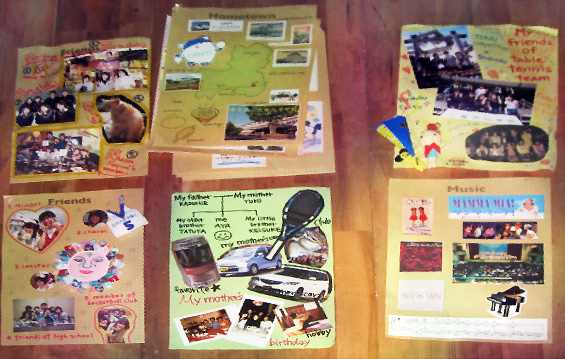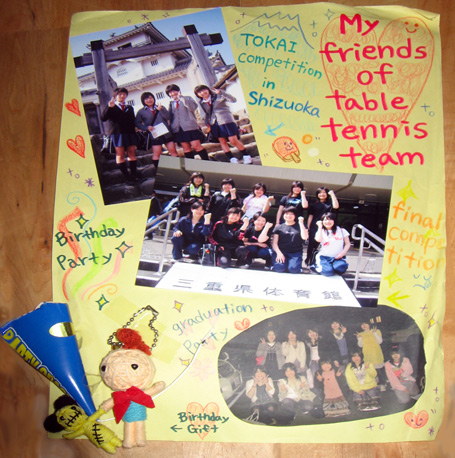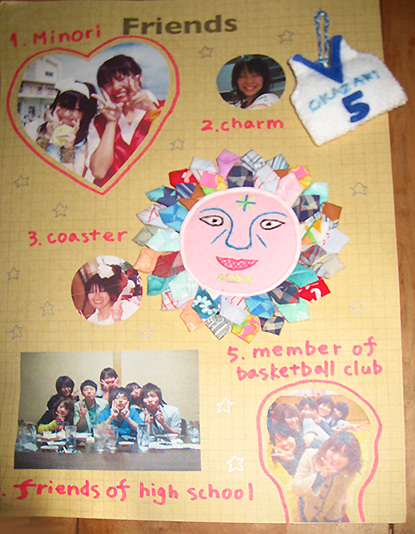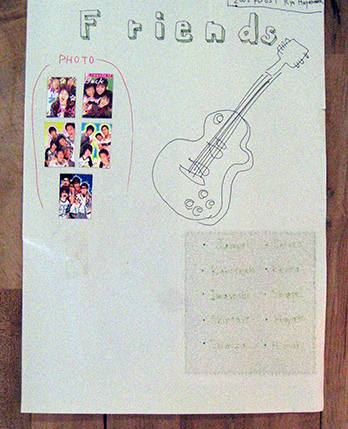
The Infinite Possibilities of Scrapbooksby Sarah Mulvey (Nanzan University) & Brian Cullen (Nagoya Institute of Technology) |
| "there is nothing as effective as a real scrapbook in encouraging students to talk about their own lives and to encourage other students to ask them genuinely interested questions about it." |
[ p. 1 ]
[ p. 2 ]
[ p. 3 ]
Q: How would you handle students who bring nothing to class?
A: We keep a grab-bag of items on hand for presentation days. Those students who are not prepared can choose four or five items from the grab bag and must create a short presentation with what they have chosen. It may not be as personal, but it does offer an opportunity for creativity and the student must still participate in class.
Q: What do you do if another student makes fun of a classmate's scrapbook choices?
A: In general, we have found that students are supportive and appreciative of their fellow classmates' work. Indeed, they seem to greatly enjoy the opportunity of learning about the lives of their classmates outside the classroom. In the rare case where one student might appear to be making fun of another student's work, be sure to remind students to be respectful of their classmates' work, and caution any student who is in violation of this. You may need to alter your class organization if there is clearly a problem within a specific group of students.
Q: What should you do if a student expresses a concern about privacy?
A: Most students are very happy to share information about their lives and are quite sensible about setting their own limits for what they are willing to share. However, if a student does express concern about privacy, for example an unwillingness to share photographs of their family, give them the option of creating their own drawings, or even focusing on a famous family in popular culture.
Q: What do you do if a student uses an inappropriate item?
A: Be aware that there is often a generational and cultural difference between teachers and students, so what may appear as inappropriate to you may not always be so to the students. However, if an item in a scrapbook is obviously inappropriate, for example a pornographic image or drug paraphernalia, take the student aside, and explain that the item must be removed before the presentation can continue.
Student Name: I am happy to let my teacher use copies or photos of my scrapbook for future classes, discussions with other teachers, or research papers. Signed: |
[ p. 5 ]
McIvor, K. and Mason, S. (2006). The Encyclopedia of Scrapbooking Techniques. Tunbridge Wells, Kent, UK & Petaluma, CA: Search Press.
Example 1. Some "good" Japanese university EFL scrapbook samples.

[ p. 6 ]
Examples 2 and 3 give a closer view of the use of realia. Adding these makes the scrapbooks three-dimensional and creates a much bigger impact.[ p. 7 ]
Example 2. A detailed image of a "good" Japanese university EFL scrapbook page.

[ p. 8 ]
Example 3. Another detailed image of a "good" Japanese university EFL scrapbook page.

[ p. 9 ]
Example 4. One poorly designed Japanese university EFL scrapbook page.

[ p. 10 ]
Do
- Start off your presentation with a strong beginning, e.g. "Hi, I'm Toshiko. I would like to tell you about my family."
- Be sure to give a strong ending to your presentation, e.g. "Thank you for listening. Do you have any questions about my scrapbook?"
- Use transition words to introduce each item on your scrapbook, e.g. "In this picture… or "If you look closely, you can see…" or "This photo was taken…"
- Explain why each item is important to you, e.g. "This is my favourite picture because it shows …" or "I chose this because…"
- Prepare at least a few sentences about each item in your scrapbook.
- Try to use simple English so that people can understand. If you use difficult words, explain them.
- Practice explaining your scrapbook before class.
- Speak in a loud voice, smile, make eye contact, and use gestures.
- Choose items that will be interesting for other people.
- Add colour and key words to make your scrapbook page look attractive and interesting.
Don't
- Read your presentation. If you practice, a few short notes as prompts on the back of your scrapbook page will be enough to help you remember.
- Prepare only just before your presentation.
- Practice your presentation while other people are explaining their scrapbooks.
- Be nervous! Relax and have fun sharing your scraps.
- Don't use very small items. You want people to be able to see your scraps.
|
Some possible items to use in your scrapbook:
a photo, a concert ticket, a letter, origami, a postcard, a phone bill, a map, a candy wrapper, a receipt, a sketch, a CD cover, a newspaper article, an airplane ticket, song lyrics, a shopping list, a lock of hair, a birthday card, a new year's card, a Christmas card … it's your scrapbook - have fun, and make it interesting! |
[ p. 11 ]